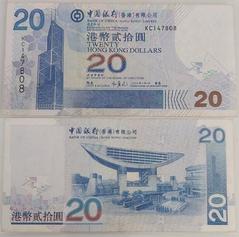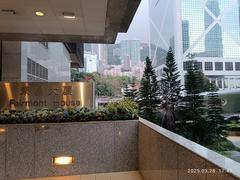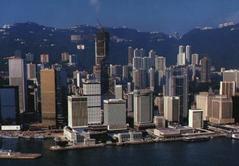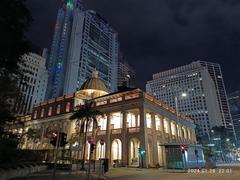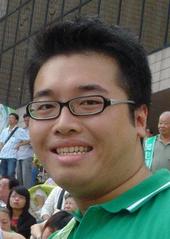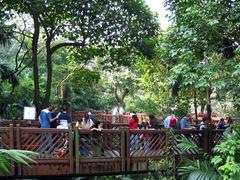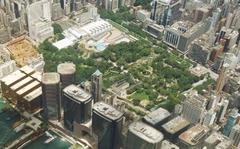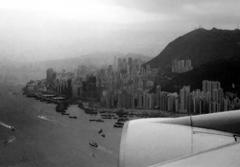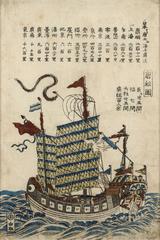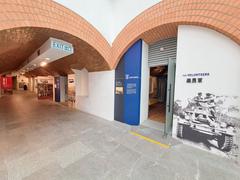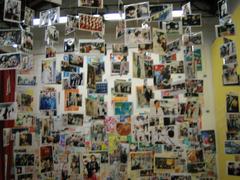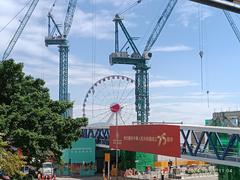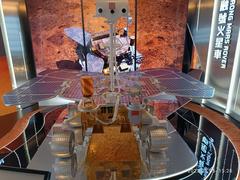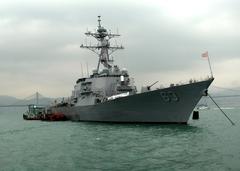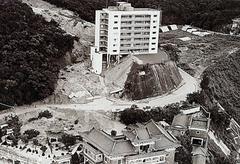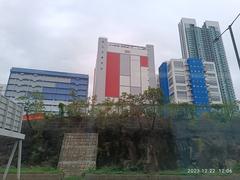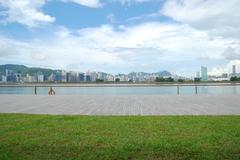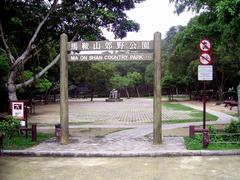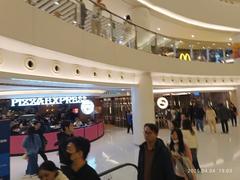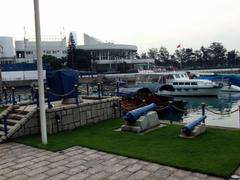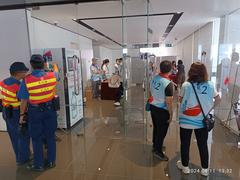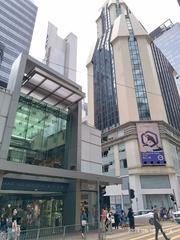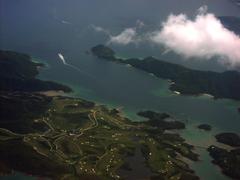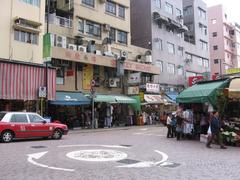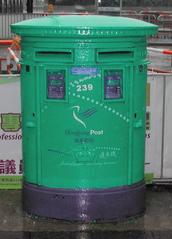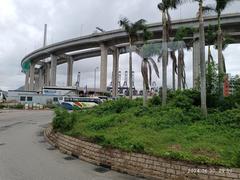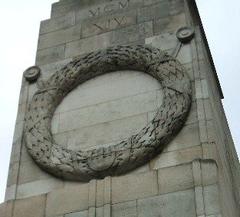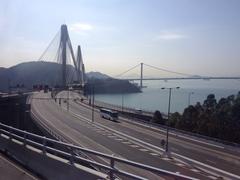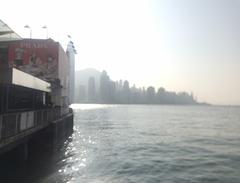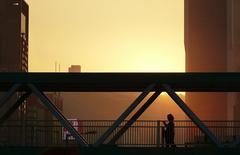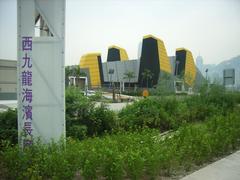
Visiting 中銀大廈 Bank of China Tower: Hours, Tickets, and Tips
Publication Date: 23/07/2024
Introduction to Bank of China Tower
The Bank of China Tower, known locally as 中銀大廈, is an architectural gem and a significant landmark in Hong Kong’s Central District. Designed by the legendary Chinese-American architect I.M. Pei, this iconic skyscraper was completed in 1990 and quickly became a symbol of modernity and economic strength (ArchDaily). Standing at 367.4 meters (1,205 feet) with 72 floors, the tower was the tallest building in Hong Kong and Asia upon its completion, a title it held until 1992 (Skyscraper Center). The design of the BOC Tower draws inspiration from bamboo, a plant symbolizing growth and prosperity in Chinese culture, which is reflected in its geometric, triangular frameworks and sharp angles. This bold aesthetic was a departure from traditional architectural forms and has been celebrated for its innovative approach (South China Morning Post).
The Bank of China Tower is not just an architectural feat but also a cultural symbol. It incorporates elements of feng shui, a traditional Chinese practice that emphasizes harmony with the environment. However, its sharp angles and pointed edges have sparked controversy among feng shui practitioners, who believe such features can bring negative energy. Despite this, the tower remains a powerful symbol of modernity and progress (Hong Kong Economic Journal).
The construction of the BOC Tower occurred during a period of rapid economic growth and transformation in Hong Kong. The 1980s and 1990s were marked by significant investments in infrastructure and real estate, driven by Hong Kong’s status as a major financial center. The building’s completion underscored the Bank of China’s commitment to expanding its presence in international markets (Hong Kong Monetary Authority).
Visiting the Bank of China Tower offers a unique opportunity to experience one of Hong Kong’s most iconic structures. The observation deck on the 43rd floor provides stunning views of Victoria Harbour and the surrounding cityscape, making it a popular attraction for both locals and tourists (Discover Hong Kong).
Contents Overview
- Architectural Vision and Design
- Construction and Engineering Feats
- Symbolism and Cultural Significance
- Historical Context and Economic Impact
- Milestones and Recognition
- Preservation and Modernization
- Influence on Future Developments
- Visitor Experience and Tips
Architectural Vision and Design
The Bank of China Tower (BOC Tower) in Hong Kong is an iconic skyscraper that stands as a testament to modern architectural innovation and the economic prowess of Hong Kong. Designed by the renowned Chinese-American architect I.M. Pei, the tower was completed in 1990 and quickly became one of the most recognizable structures in the city’s skyline. The design of the BOC Tower is inspired by the form of bamboo, symbolizing growth and prosperity. The building’s geometric design, characterized by its triangular frameworks and sharp angles, was a departure from traditional architectural forms and has been celebrated for its bold aesthetic (ArchDaily).
Construction and Engineering Feats
The construction of the BOC Tower was a significant engineering achievement. Standing at 367.4 meters (1,205 feet) with 72 floors, it was the tallest building in Hong Kong and Asia upon its completion and held the title until 1992. The building’s structural system is based on a steel frame with a glass curtain wall, which was a pioneering approach at the time. The use of steel allowed for a lighter structure compared to traditional concrete, enabling the unique design to be realized. The tower’s construction required meticulous planning and execution, particularly in the context of Hong Kong’s dense urban environment (Skyscraper Center).
Symbolism and Cultural Significance
The BOC Tower is not just an architectural marvel but also a symbol of China’s economic ambitions and Hong Kong’s role as a global financial hub. The building’s design incorporates elements of feng shui, a traditional Chinese practice that emphasizes harmony with the environment. However, its sharp angles and pointed edges have been a subject of controversy among feng shui practitioners, who believe that such features can bring negative energy. Despite this, the tower remains a powerful symbol of modernity and progress (South China Morning Post).
Historical Context and Economic Impact
The construction of the BOC Tower occurred during a period of rapid economic growth and transformation in Hong Kong. The 1980s and 1990s were marked by significant investments in infrastructure and real estate, driven by Hong Kong’s status as a major financial center. The BOC Tower was part of a broader trend of skyscraper construction that reshaped the city’s skyline and reinforced its global economic position. The building’s completion was a milestone that underscored the Bank of China’s commitment to expanding its presence in international markets (Hong Kong Economic Journal).
Milestones and Recognition
Since its completion, the BOC Tower has received numerous accolades and recognition for its architectural and engineering excellence. It has been featured in various architectural publications and has become a popular subject for photographers and tourists alike. The building’s unique design and prominent location make it a focal point in Hong Kong’s Central District, attracting visitors from around the world. The tower’s observation deck, located on the 43rd floor, offers panoramic views of the city and is a popular attraction for both locals and tourists (Time Out Hong Kong).
Preservation and Modernization
Over the years, the BOC Tower has undergone several renovations and upgrades to maintain its status as a modern office building. These efforts have included updates to its mechanical systems, enhancements to its energy efficiency, and improvements to its public spaces. The building’s management has also implemented measures to preserve its architectural integrity while adapting to the evolving needs of its occupants. These initiatives ensure that the BOC Tower remains a relevant and functional landmark in Hong Kong’s ever-changing urban landscape (Building Design + Construction).
Influence on Future Developments
The success and prominence of the BOC Tower have had a lasting impact on architectural and urban development in Hong Kong and beyond. Its innovative design has inspired subsequent skyscrapers and has set a benchmark for architectural excellence in the region. The tower’s integration of modern engineering techniques with cultural symbolism has influenced a new generation of architects and designers, who seek to create buildings that are both functional and meaningful. The BOC Tower’s legacy continues to shape the future of urban development in Hong Kong and serves as a model for sustainable and visionary architecture (Architectural Digest).
Visitor Experience and Tips
For visitors, the BOC Tower offers a unique opportunity to experience one of Hong Kong’s most iconic buildings. The observation deck on the 43rd floor provides stunning views of Victoria Harbour and the surrounding cityscape. It is advisable to visit during clear weather to fully appreciate the panoramic vistas. The building is easily accessible via public transportation, with the Central MTR station located nearby. Visitors should also take the time to explore the surrounding Central District, which is home to numerous other landmarks, shopping destinations, and dining options (Discover Hong Kong).
Practical Information for Visitors
Location and Accessibility
The BOC Tower is conveniently located in the Central District of Hong Kong, making it easily accessible by public transportation. The nearest MTR station is Central Station, which is a short walk from the tower. Visitors can also reach the tower via numerous bus routes and the iconic Hong Kong tram system (MTR Corporation).
Opening Hours
The building is open to the public from Monday to Friday, 9:00 AM to 6:00 PM. The observation deck follows the same hours, but it is advisable to check for any changes or special closures on the official website before planning a visit (BOC Hong Kong).
Ticket Prices
Entry to the observation deck is free of charge, making it an excellent budget-friendly attraction for tourists (Discover Hong Kong).
Accessibility for People with Disabilities
The Bank of China Tower is equipped to accommodate visitors with disabilities. There are ramps, elevators, and accessible restrooms available throughout the building (BOC Hong Kong).
Nearby Attractions
Visitors to the BOC Tower can also explore nearby attractions such as the Hong Kong Park, the Central-Mid-Levels Escalator, and the historic St. John’s Cathedral. These sites offer a mix of natural beauty, modern convenience, and historical significance, providing a well-rounded experience of Hong Kong’s Central District (Hong Kong Tourism Board).
Tips for a Memorable Visit
Best Time to Visit
To avoid the crowds and enjoy a more relaxed experience, it is best to visit the BOC Tower early in the morning or late in the afternoon. Weekdays are generally less crowded than weekends, making it easier to explore the observation deck and other facilities without long waits (TripAdvisor).
Photography
The BOC Tower is a popular spot for photography enthusiasts. The building’s unique design and the stunning views from the observation deck provide ample opportunities for capturing memorable shots. It is advisable to bring a good quality camera and visit during clear weather for the best photos (National Geographic). The best spots for photography include the observation deck and the ground level where the tower’s full height can be captured.
Safety and Security
Security is a top priority at the BOC Tower. Visitors are required to go through security checks before entering the building. It is important to carry a valid ID and avoid bringing prohibited items to ensure a smooth entry. The building is equipped with modern safety features, including fire safety systems and emergency exits, ensuring a safe visit for all (BOC Hong Kong).
Conclusion
In summary, the Bank of China Tower stands as a monumental achievement in architecture and engineering, reflecting the economic dynamism and cultural heritage of Hong Kong. Its history is intertwined with the city’s growth and development, making it a must-visit destination for anyone interested in the intersection of modernity and tradition.
FAQ
- What are the Bank of China Tower visiting hours? The Bank of China Tower is open to visitors during regular business hours, typically from 9:00 AM to 5:00 PM on weekdays.
- How do I buy tickets for the Bank of China Tower observation deck? Tickets for the observation deck can be purchased on-site or through the official website.
- What is the best time to visit the Bank of China Tower? The best time to visit is during clear weather to enjoy the panoramic views from the observation deck. Early mornings or late afternoons are ideal for avoiding crowds.
Photographic Spots
- The plaza in front of the Bank of China Tower offers an excellent vantage point for capturing the building’s full height and unique design.
- The observation deck provides stunning views of Victoria Harbour and the cityscape, perfect for panoramic shots.
Travel Tips and Nearby Attractions
- The Central District is rich with attractions such as the Hong Kong Park, the Peak Tram, and the IFC Mall. Make sure to allocate time to explore these nearby sites.
- Public transportation is highly efficient; use the MTR to navigate the area conveniently.
- Local eateries and cafes in the Central District offer a variety of dining options to complement your visit.
Call to Action
Plan your visit to the Bank of China Tower today! Download our mobile app Audiala for more travel tips and check out other related posts on our blog. Follow us on social media for the latest updates and recommendations.
